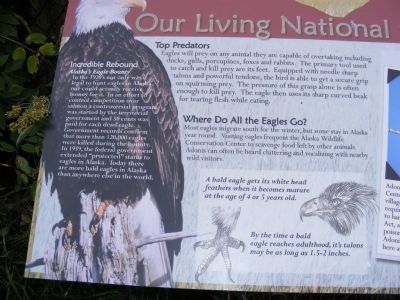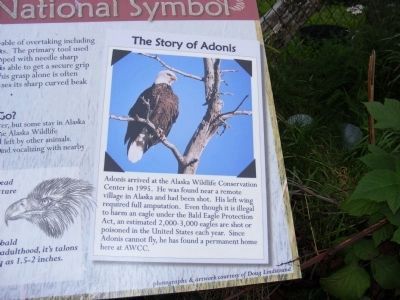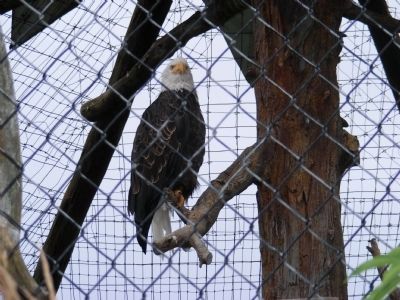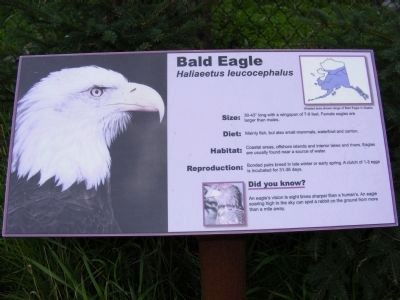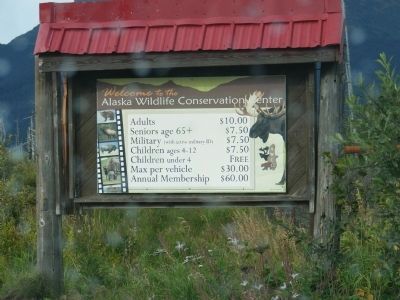Anchorage, Alaska — Northwest (North America)
Our Living National Symbol
Alaska Wildlife Conservation Center
Inscription.
Top Predators
Eagles will prey on any animal they are capable of overtaking including ducks, gulls, porcupines, foxes and rabbits. The primary tool used to catch and kill prey are its feet. Equipped with needle sharp talons and powerful tendons, the bird is able to get a secure grip on squirming prey. The pressure of this grasp alone is often enough to kill prey. The eagle then uses its sharp curved beak for tearing flesh while eating.
Where Do All the Eagles Go?
Most eagles migrate south for the winter, but some stay in Alaska year around. Visiting eagles frequent the Alaska Wildlife Conservation Center to scavenge food left by other animals. Adonis can often be heard chittering and vocalizing with nearby wild visitors.
A bald eagle gets its white head feathers when it becomes mature at the age of 4 or 6 years old. By the time a bald eagle reaches adulthood, it’s talons may be as long as 1.5-2 inches.
Incredible Rebound
Alaska’s Eagle Bounty
In the 1920s not only was it legal to hunt eagles in Alaska, one could actually receive money for it. In an effort to control competition over salmon a controversial program was started by the territorial government and 50 cents was paid for each dead eagle. Government records confirm that more than 120,000 eagles were killed during the bounty. In 1959, the federal government extended “protected” status to eagles in Alaska. Today here are more bald eagles in Alaska than anywhere else in the world.
The Story of Adonis
Adonis arrived in Alaska Wildlife Conservation Center in 1995. He was found near a remote village in Alaska and had been shot. His left wing required full amputation. Even though it is illegal to harm an eagle under the Bald Eagle Protection Act, an estimated 2,000-3,000 eagle are shot or poisoned in the United States each year. Since Adonis cannot fly, he has found a permanent home here at AWCC.
Topics. This historical marker is listed in this topic list: Animals. A significant historical year for this entry is 1959.
Location. 60° 49.283′ N, 148° 59.049′ W. Marker is in Anchorage, Alaska. Marker is on Seward Highway. The marker is on the grounds of the Alaska Wildlife Conservation Center. Touch for map. Marker is in this post office area: Girdwood AK 99587, United States of America. Touch for directions.
Other nearby markers. At least 6 other markers are within 5 miles of this marker, measured as the crow flies. A Prickly World (about 300 feet away, measured in a direct line); Moose Calves (about 400 feet away); Brown Bears of AWCC (approx. 0.2 miles away); 1964 Earthquake (approx. 0.2 miles away); Atlantic Salmon-A Threat to the Chugach National Forest?
(approx. 4.3 miles away); Coho Salmon Life Cycle (approx. 4.3 miles away).
Regarding Our Living National Symbol. There is an occurrence of "it's talons", which should have omitted the apostrophe for possessive form of "it".
Credits. This page was last revised on April 13, 2021. It was originally submitted on December 11, 2013, by Don Morfe of Baltimore, Maryland. This page has been viewed 609 times since then and 17 times this year. Last updated on April 13, 2021, by Carl Gordon Moore Jr. of North East, Maryland. Photos: 1, 2, 3, 4, 5. submitted on December 11, 2013, by Don Morfe of Baltimore, Maryland. • J. Makali Bruton was the editor who published this page.
